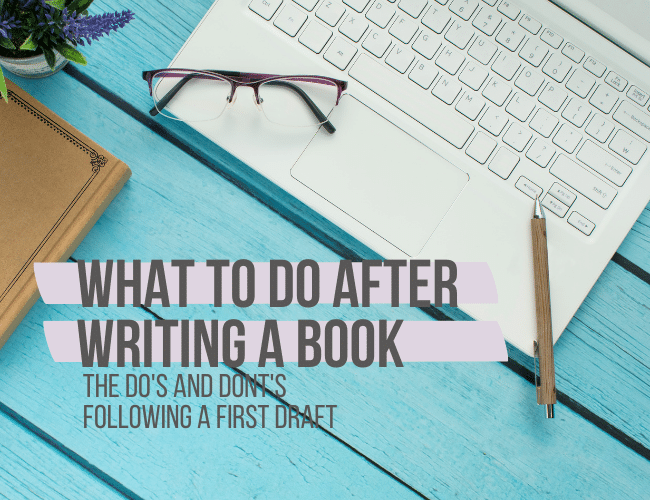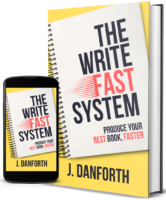If you've finished writing a first draft, you’ve accomplished something huge. You've brought your book idea to life and should be proud of yourself! But once the celebration dies down, you might experience a moment of silence as you look at your finished manuscript. You wonder: What comes next?

Maybe you’re not sure what you should do next, or maybe you have an idea of all the things that could follow and feel disorganized and paralyzed by all the possibilities.
The fact is, a lot of budding writers don’t think beyond the “finishing the book” part of writing.
So what is next? This article teaches you what to do after writing a book.
This article is an excerpt from my new book, The Write Fast System. Grab a copy and finish your book faster!
 Want to finish your best book faster? Get our new book, The Write Fast System, today (on sale for a limited time)!
Want to finish your best book faster? Get our new book, The Write Fast System, today (on sale for a limited time)!Get The Write Fast System – $2.99 »
My FIRST First Draft
I finished my very first first draft in 2011. It was too long (about 145K) and poorly plotted (back in the days before I learned what good writing was), though not a totally pathetic attempt for a first novel.
I sat on this book for several months, then decided to send it off to a proofreader and self publish it.
Not surprisingly, it sunk like a stone into the corners of the internet, never to be heard from again.
My SECOND First Draft
My second first draft was a bit more complicated.
I had participated and completed several NaNoWriMos, during which I wrote several short novels in the 50K-60K word range. Several of them had similar themes.
After my first book didn’t go anywhere, I took out a few of these, compile them into one, slapped a title on it, and called it a book.
As you probably guessed by now, I never rewrote any of these stories. I simply dumped them together into the semblance of a book.
This book never saw the light of day. After throwing it together, I never even bothered paying for the editing and publishing that I did for the first book. This book sat on my computer for a number of years, until the computer crashed and I lost the manuscript completely.
To be perfectly honest, I’m not especially sad about it. Deep down, I knew it wasn’t up to snuff.
My THIRD First Draft
It wasn’t until my third first draft, Headspace, that I finally humbled myself enough to learn exactly how to treat a first draft. This book is the reason I went on to write my fourth, fifth, and sixth first drafts within the span of two years.
So what changed?
What NOT to Do After Your First Draft
Before we go into what I learned from my third book, I want to talk about a few things not to do with your first draft.
These are lessons that I learned the hard way and hope that by sharing them, you won’t have to learn them the same way.
Do NOT think of your book as “done”
A first draft is a beginning, not an end.
If you’ve never finished a book before, you may feel like you’ve reached some kind of finish line.
The more appropriate way to think is that you’ve reached the end of your first chapter. It is certainly an accomplishment but there is still plenty of work ahead.
Do NOT be afraid of editing
I was afraid of editing.
I admit it. The thought of editing so many pages seemed incredibly scary and daunting, and this is ultimately the reason I never attempted to edit my first and second book.
Editing a book for the first time can be intimidating indeed, but as I will cover later, all you need is a method and a plan.
Do NOT publish your first draft
Maybe there are some literary geniuses out there who turn out a perfect book on their first try, but realistically, that is not the case for us commoners. The majority of first drafts are not ready for literary agents, a publishing house, or even to see the light of day.
The self-publishing process is easy and available these days with services like Kindle Direct Publishing, but the fact is, ease of access do not always produce successful authors. Publishing my first draft without going through a plot editing process was one of the biggest mistakes I ever made as a writer. A first draft is a starting point, not a finished book.
Remember, writing a book doesn’t make it good, rewriting it does.
What to Do After Your First Draft
I am all about making plans. The truth is, having a plan makes me feel a lot less anxious when I have too many options or too many things to do.
If you’re anything like I used to be, lost and confused after you finish your book, trying following the steps below:
1. Take a break (but not for too long)
You’ve probably heard the advice of walking away from your book to rest your mind. This is important, but I want to add something to that—rest with purpose.
This break should not be too long because being away from the world of your story for too long may cause you to lose the momentum needed to properly edit the book. I recommend no more than two weeks.
During this time, you will find your mind wandering back to the story periodically.
You should not actively try to solve the problems within your book during this time, but there’s no way to fully keep your mind off your newly completed novel.
If something comes up, write it down and set it aside. Let your mind drift in and out of the story world without restriction. You might be surprised at what pops up.
Your goal during this period is to try to not try too hard after staying focused for so long to write your first draft.
2. Read a book
Read a book during your break. I recommend either a book on writing that preferably pertains to something you’re trying to work on in your own story—dialogue, setting, development, something else—or a book in the same genre by someone established. You can even take this time to read up on book marketing and learn how a successful book reaches its target audience.
The first gets your mind into a fixing mode, and the later helps inspire new ideas and connections. There are plenty of resources out there for whatever brain boost you might need.
Which will help relax your brain, and find new energy to tackle your story when you return to it?
3. Perform a plot treatment
I've gone into detail about how to create a plot treatment on the blog before. The plot treatment is very helpful to fiction writers (and may be adapted for nonfiction as well). Essentially, it is a detailed synopsis of each chapter and what you intended to happen in it. It incorporates notes from the revision list if you kept one.
As you write the plot treatment, try to keep an open mind. Be willing to make big changes and “kill your darlings,” as some say. If you have access to a developmental editor or someone who can help with structural edit, this is a good time to consult with them.
This is a space to experiment and rearrange. Keep in mind that making changes here will be a lot easier than making changes in a later draft, and having the plot treatment as a guide will make the revision process much easier.
4. Rewrite (not tweak) you story
A major mistake I made with my very first book was that I had a fundamentally wrong idea of what “editing” meant in the early stages of writing a book. I thought I had to write the entire book then tweak and fix this book a little at a time until it was perfect.
Have you tried “tweaking” a 400 page book into perfection? It doesn’t work.
At least not after the first draft. The first draft is messy and flawed, as it should be.
The biggest favor you can do for your book is to rewrite it.
Start a new document, consult your plot treatment, and rewrite it fresh. This not only gives you far greater control over the story, but frees you from the constraints of what was written in the first draft.
What if you encounter a segment in the first draft that doesn’t need much fixing? Simple, copy it over to draft two.
I do this all the time. Between the plot treatment, the revision list, and being able to recycle parts of the first draft, you will find that your second draft is much smoother, easier, and less of a headache to write.
Take Your Time
I’m a firm believer in the speedy first draft. Get it down, get it out, as fast as you can before it runs away from you.
But the second draft is different. This is where you get to slow down and savor the story, really think about themes, details, and the philosophies, if any, you want to convey to your readers.
You have this luxury because your first draft and plot treatment have already provided you with a solid foundation for your entire story and laid out where the anchors for major events. No matter how messy your first draft is, your story is more grounded than before you started it.
Of course, that doesn’t mean you should let your second draft go on forever. I previously recommended six weeks for a first draft. For the second draft, I recommend double that time—twelve weeks, or three months.
This should allow you ample time to think, play, and really enjoy the world you created. Better, it will keep you motivated to bring your book from its first and second drafts into any future drafts, until it's ready to publish.
What do you do after writing a first draft? Let us know in the comments.
PRACTICE
For today's writing practice, let's practice what to do after writing a first draft—and taking a short break. Take one scene from you manuscript that you know you'll need to rewrite.
First, take some time to write a quick summary on what needs to happen in it, or refer to your plot treatment.
Now, for fifteen minutes, rewrite this scene. Follow your summary and/or plot treatment as best you can, but also give yourself permission for some creative exploration. When you’re finished, share your work in the Pro Practice Workshop here (and if you’re not a member yet, you can join here).
When you're done, let us know how this process went for you in the comments. And if you have some time, give some feedback to your fellow writers!
J. D. Edwin is a daydreamer and writer of fiction both long and short, usually in soft sci-fi or urban fantasy. Sign up for her newsletter for free articles on the writer life and updates on her novel, find her on Facebook and Twitter (@JDEdwinAuthor), or read one of her many short stories on Short Fiction Break literary magazine.



0 Comments